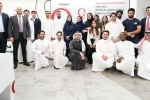
Municipal governments and private-sector players are designing “smart cities” that use technology to make urban centers more livable. These approaches are vital as the world’s urban population continues to grow. Over 4 billion people live in cities worldwide, a number projected to reach 9.7 billion, 75% of the global population, 30 years from now. The range of smart city applications can be overwhelming, from traffic management to security, education, and health care. Still, Middle East cities can join with private sector players and other stakeholders to begin with two proven use case that offer quick wins: smart parking and digital signage.
“Parking is a major revenue stream for most cities, and a source of frustration for drivers.”
A smart city uses platform-based technologies like data analytics and artificial intelligence to understand how specific services can function more efficiently. Equipped with data, policymakers can make better decisions, ease the strain on infrastructure, and meet residents’ needs. Although some applications are still in development and untested, smart parking and digital signage are already in wide usage and generating benefits.
Parking is a major revenue stream for most cities, and a source of frustration for drivers. Most fast-growing cities have too few parking spaces, particularly in downtown areas. Drivers have little real-time data about available spacing, forcing them to circle their destination to find a spot. One study, by the San Francisco Municipal Transportation Agency, found that this excessive driving increases traffic volume in congested downtown areas by up to 30%.
Smart parking alleviates the strain by collecting real-time information about parking availability and providing it to drivers through an app. Drivers use the app to reserve a space near their destination, paying if needed. Dynamic pricing allows cities to charge more for attractive spots. This allows consumers to choose how much they are willing to pay for a spot or whether to drive at all. The result is more revenue for cities, less congestion, reduced emissions, and a better experience for drivers and pedestrians.
Currently, 11% of global parking spaces are smart, according to a report from IoT Analytics. That same report found that spending on smart parking products and services is forecast to grow at a compound annual rate of 14% and exceed $3.8 billion by 2023. Amsterdam, which began applying a smart-city approach in 2009, provides smart parking.
The hardware that supports smart parking is already available, including sensors that can detect whether spaces are empty, cameras that automatically capture license plates, and mobile-enabled towing services to keep spaces available.
A unified platform for digital signage is another widespread use case. Currently, most city signs are traditional billboards, and even when they are digital, the market is highly fragmented, which means that advertisers struggle to access a critical mass. For investors, fragmentation means increased marketing, sales, and transaction costs, creating a low return on investment.
A unified platform for digital signage could address these challenges, helping public and private entities contact residents in a more interactive and engaging way. Advertisers can get their messages in front of public audiences more easily and efficiently. Investors can see higher utilization of the signage space they control, even allowing multiple advertisers to share the same space on a rolling loop of content. City authorities that own and lease properties that house signs can charge higher fees and easily regulate content.
Oslo has implemented smart signage in malls and across highways. The city also uses digital signs at airport security checkpoints to communicate updated regulations and other customized content.
Digital signage required special equipment such as interactive touch screens. A centralized platform enables investors to manage their inventory and set pricing, and allows advertisers to see and buy available signage space, make payments, and manage campaigns.
There are three main success factors for smart parking and digital signages. First, cities should avoid competing solutions. Instead, they should develop a single, integrated, city-wide marketplace to increase adoption among users and ensure comprehensive data. Second, cities should use the latest technologies, particularly 5G connectivity. Third, city governments must partner with private-sector technology players to develop these solutions.
Some smart-city applications are extremely sophisticated and high-risk, smart parking and digital signage are relatively straight forward to introduce. Governments that adopt these technologies can use readily available software and hardware to shorten the implementation time. Moreover, these governments will begin to build digital capabilities, generating momentum for more ambitious measures in the future.
This article originally appeared in ITP.net, January 2021.
About the authors
Jad Hajj is a partner, Ramzi Khoury is a principal, and Antoine Lamaa is a manager, with Strategy& Middle East, part of the PwC network.
Contact us


















Menu